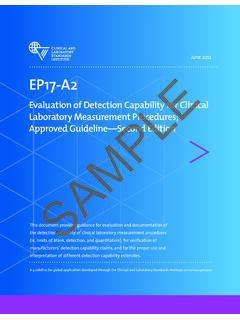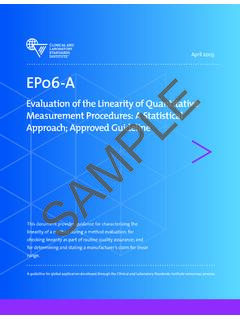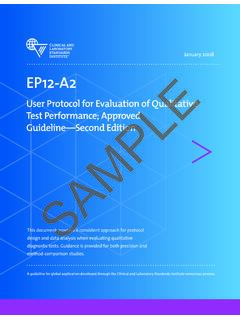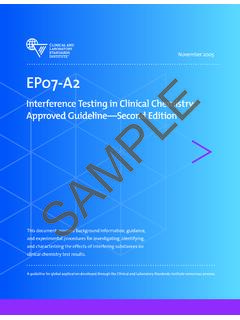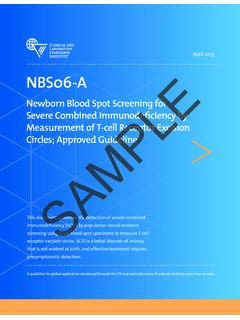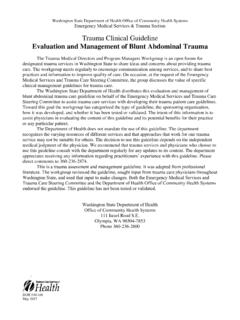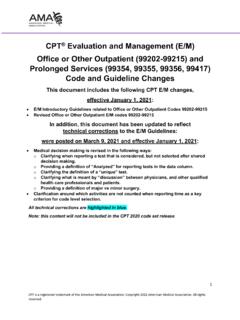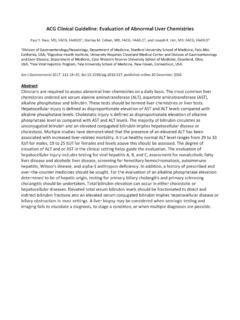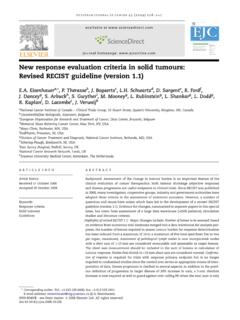Transcription of EP25-A: Evaluation of Stability of In Vitro Diagnostic ...
1 September 2009EP25-AEvaluation of Stability of In Vitro Diagnostic Reagents; Approved GuidelineThis document provides guidance for establishing shelf-life and in-use Stability claims for in Vitro Diagnostic reagents such as reagent kits, calibrators, and control guideline for global application developed through the Clinical and Laboratory Standards Institute consensus process. SAMPLEC linical and Laboratory Standards InstituteSetting the standard for quality in clinical laboratory testing around the Clinical and Laboratory Standards Institute (CLSI) is a not-for-profit membership organization that brings together the varied perspectives and expertise of the worldwide laboratory community for the advancement of a common cause: to foster excellence in laboratory medicine by developing and implementing clinical laboratory standards and guidelines that help laboratories fulfill their responsibilities with efficiency, effectiveness, and global applicability.
2 Consensus ProcessConsensus the substantial agreement by materially affected, competent, and interested parties is core to the development of all CLSI documents. It does not always connote unanimous agreement, but does mean that the participants in the development of a consensus document have considered and resolved all relevant objections and accept the resulting agreement. Commenting on DocumentsCLSI documents undergo periodic Evaluation and modification to keep pace with advancements in technologies, procedures, methods, and protocols affecting the laboratory or health s consensus process depends on experts who volunteer to serve as contributing authors and/or as participants in the reviewing and commenting process. At the end of each comment period, the committee that developed the document is obligated to review all comments, respond in writing to all substantive comments, and revise the draft document as appropriate.
3 Comments on published CLSI documents are equally essential, and may be submitted by anyone, at any time, on any document. All comments are addressed according to the consensus process by a committee of experts. Appeals ProcessIf it is believed that an objection has not been adequately addressed, the process for appeals is documented in the CLSI Administrative comments and responses submitted on draft and published documents are retained on file at CLSI and are available upon request. Get Involved Volunteer! Do you use CLSI documents in your workplace? Do you see room for improvement? Would you like to get involved in the revision process? Or maybe you see a need to develop a new document for an emerging technology? CLSI wants to hear from you. We are always looking for volunteers. By donating your time and talents to improve the standards that affect your own work, you will play an active role in improving public health across the further information on committee participation or to submit comments, contact and Laboratory Standards Institute950 West Valley Road, Suite 2500 Wayne, PA 19087 USA P: : EP25-A Vol.
4 29 No. 20 ISBN 1-56238-706-5 Replaces EP25-P ISSN 0273-3099 Vol. 28 No. 32 Evaluation of Stability of In Vitro Diagnostic Reagents; Approved Guideline Volume 29 Number 20 James F. Pierson-Perry Sousan S. Altaie, PhD Susan J. Danielson, PhD Birgitte Lund Jorgensen, PhD Bettina Poetsch, PhD Rosanne M. Savol, RAC Jeffrey E. Vaks, PhD Jeffrey Budd, PhD Karl De Vore Robert Magari, PhD Abstract Clinical and Laboratory Standards Institute document EP25-A Evaluation of Stability of In Vitro Diagnostic Reagents; Approved Guideline provides guidance and regression-based procedures for establishing Stability -related claims of in Vitro Diagnostic (IVD) reagents such as reagent kits, calibrators, control products, and sample diluents.
5 This guideline was written primarily for manufacturers and regulatory agencies, but will also be of interest to clinical laboratories. It provides information on the design, implementation, data analysis, and documentation needs for studies to establish and verify shelf life and in-use life of IVD reagents. Additional topics address assessment of product transport conditions on Stability and accelerated Stability testing. Clinical and Laboratory Standards Institute (CLSI). Evaluation of Stability of In Vitro Diagnostic Reagents; Approved Guideline. CLSI document EP25-A (ISBN 1-56238-706-5). Clinical and Laboratory Standards Institute, 950 West Valley Road, Suite 2500, Wayne, Pennsylvania 19087 USA, 2009. The Clinical and Laboratory Standards Institute consensus process, which is the mechanism for moving a document through two or more levels of review by the health care community, is an ongoing process.
6 Users should expect revised editions of any given document. Because rapid changes in technology may affect the procedures, methods, and protocols in a standard or guideline, users should replace outdated editions with the current editions of CLSI documents. Current editions are listed in the CLSI catalog and posted on our website at If your organization is not a member and would like to become one, and to request a copy of the catalog, contact us at: Telephone: ; Fax: ; E-Mail: Website: SAMPLEN umber 20 EP25-A iiCopyright 2009 Clinical and Laboratory Standards Institute. Except as stated below, any reproduction of content from a CLSI copyrighted standard, guideline, companion product, or other material requires express written consent from CLSI. All rights reserved.
7 Interested parties may send permission requests to CLSI hereby grants permission to each individual member or purchaser to make a single reproduction of this publication for use in its laboratory procedure manual at a single site. To request permission to use this publication in any other manner, e-mail Suggested Citation CLSI. Evaluation of Stability of In Vitro Diagnostic Reagents; Approved Guideline. CLSI document EP25-A. Wayne, PA: Clinical and Laboratory Standards Institute; 2009. Proposed Guideline December 2008 Approved Guideline September 2009 ISBN 1-56238-706-5 ISSN 0273-3099 SAMPLEV olume 29 EP25-A vContents Abstract .. i Committee Membership .. iii Foreword .. vii 1 Scope .. 1 2 Standard Precautions .. 1 3 Terminology .. 1 A Note on Terminology .. 1 Definitions .. 2 Abbreviations and Acronyms.
8 4 4 Overview of the Stability Testing Process .. 4 Operational Definition of Stability .. 5 Types of Stability Studies .. 8 Stability Study Design Options .. 9 The Stability Testing Plan .. 9 Extension to Qualitative Methods .. 11 Documentation of Stability Studies .. 11 5 Real-time Stability Study Protocol .. 11 Planning .. 11 Experimental .. 12 Data Analysis .. 13 6 Real-time Stability Monitoring (Verification) .. 15 7 Accelerated Stability Testing .. 15 Applications of Accelerated Stability Testing .. 15 Considerations for Planning Temperature-Based Accelerated Stability Studies .. 16 Analysis of Accelerated Stability Testing Data for Shelf-Life Claims .. 17 References .. 20 Appendix A. Measurand Drift Analysis Example .. 22 Appendix B. Example of Use of Arrhenius Equation With Accelerated Stability Testing Data to Predict Shelf Life of an In Vitro Diagnostic Control Product.
9 24 Appendix C. Determining the Number of Time Points and Repeats for Stability Studies Based on Linear Regression Analysis .. 26 Summary of Comments and Subcommittee Responses .. 29 Laboratory Failure Sources and CLSI Evaluation Protocols Documents .. 36 The Quality Management System Approach .. 38 Related CLSI Reference Materials .. 39 SAMPLEV olume 29 EP25-A Clinical and Laboratory Standards Institute. All rights reserved. 1 Evaluation of Stability of In Vitro Diagnostic Reagents; Approved Guideline 1 Scope This guidance document provides information on the establishment and verification of shelf-life and in-use Stability claims for quantitative and qualitative in Vitro Diagnostic (IVD) reagents. It includes background information and typical content to consider when creating a Stability testing plan for a particular product, logistics of performing the studies, recommended data analyses, and documentation of Stability claims.
10 Additional topics include assessment of product transport conditions on Stability claims, Stability monitoring (verification), and uses of accelerated Stability testing. The intended users of this guideline are primarily manufacturers of IVD reagents and regulatory agencies. Clinical laboratorians may find this information useful in interpreting commercial product Stability claims, as well as for establishing Stability attributes of laboratory-developed test methods. This guideline does not address instrument systems, laboratory equipment, software, or patient samples. Stability testing of raw materials or components of reagent kits or consumables is not addressed explicitly. The principles described in this document could, however, be adapted by manufacturers toward that purpose. 2 Standard Precautions Because it is often impossible to know what isolates or specimens might be infectious, all patient and laboratory specimens are treated as infectious and handled according to standard precautions.
